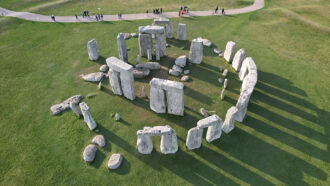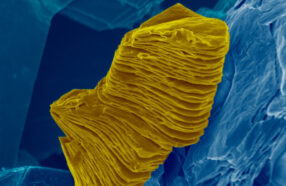astronomer: A scientist who works in the field of research that deals with celestial objects, space and the physical universe.
atom: The basic unit of a chemical element. Atoms are made up of a dense nucleus that contains positively charged protons and uncharged neutrons. The nucleus is orbited by a cloud of negatively charged electrons.
bond: (in chemistry) A semi-permanent attachment between atoms — or groups of atoms — in a molecule. It’s formed by an attractive force between the participating atoms. Once bonded, the atoms will work as a unit. To separate the component atoms, energy must be supplied to the molecule as heat or some other type of radiation.
carbon: The chemical element having the atomic number 6. It is the physical basis of all life on Earth. Carbon exists freely as graphite and diamond. It is an important part of coal, limestone and petroleum, and is capable of self-bonding, chemically, to form an enormous number of chemically, biologically and commercially important molecules. (in climate studies) The term carbon sometimes will be used almost interchangeably with carbon dioxide to connote the potential impacts that some action, product, policy or process may have on long-term atmospheric warming.
carbon nanotube: A nanoscale, tube-shaped material, made from carbon that conducts heat and electricity well.
colleague: Someone who works with another; a co-worker or team member.
core: Something — usually round-shaped — in the center of an object. (in geology) Earth’s innermost layer. Or, a long, tube-like sample drilled down into ice, soil or rock. Cores allow scientists to examine layers of sediment, dissolved chemicals, rock and fossils to see how the environment at one location changed through hundreds to thousands of years or more.
crystal: (adj. crystalline) A solid consisting of a symmetrical, ordered, three-dimensional arrangement of atoms or molecules. It’s the organized structure taken by most minerals. Apatite, for example, forms six-sided crystals. The mineral crystals that make up rock are usually too small to be seen with the unaided eye.
diamond: One of the hardest known substances and rarest gems on Earth. Diamonds form deep within the planet when carbon is compressed under incredibly strong pressure.
exoplanet: Short for extrasolar planet, it’s a planet that orbits a star outside our solar system.
graphite: Like diamond, graphite (the substance found in pencil lead) is a form of pure carbon. Unlike diamond, graphite is very soft. The main difference between these two forms of carbon is the number and type of chemical bonds between carbon atoms in each substance.
laser: A device that generates an intense beam of coherent light of a single color. Lasers are used in drilling and cutting, alignment and guidance, in data storage and in surgery.
pascal: A unit of pressure in the metric system. It is named for Blaise Pascal, the 17th century French scientist and mathematician. He developed what became known as Pascal’s law of pressure. It holds that when a confined liquid is pressed, that pressure will be transmitted throughout the liquid in all directions, without any losses.
physicist: A scientist who studies the nature and properties of matter and energy.
planet: A large celestial object that orbits a star but unlike a star does not generate any visible light.
pressure: Force applied uniformly over a surface, measured as force per unit of area.
star: The basic building block from which galaxies are made. Stars develop when gravity compacts clouds of gas. When they become hot enough, stars will emit light and sometimes other forms of electromagnetic radiation. The sun is our closest star.
trillion: A number representing a million million — or 1,000,000,000,000 — of something.
X-ray: A type of radiation analogous to gamma rays, but having somewhat lower energy.








